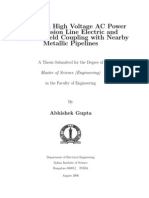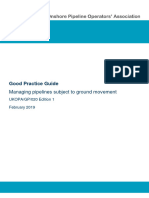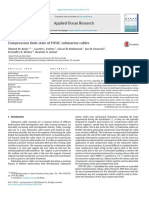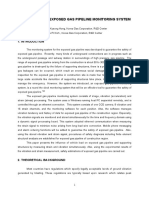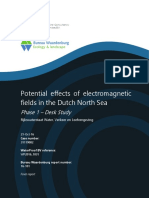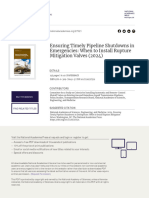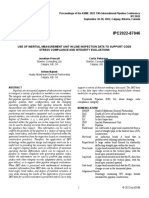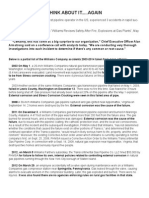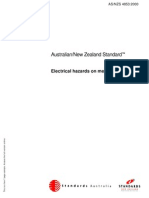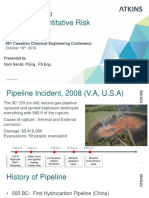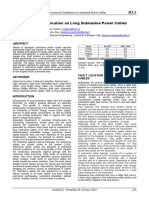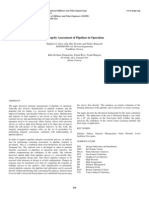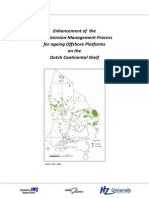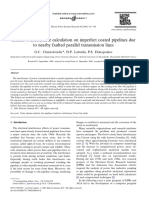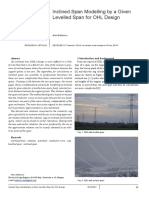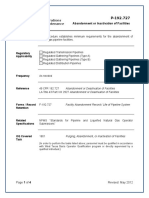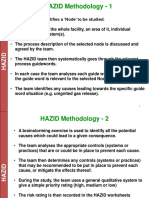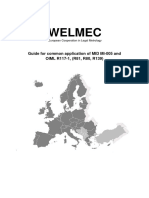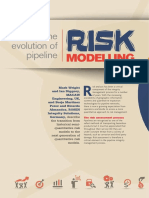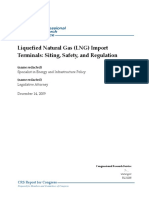Copyright © IFAC Power Plants and Power Systems Control, ELSEVIER
Seoul, Korea, 2003
IFAC
PUBLICATIONS
www.elsevier.com/locale/ifac
INFLUENCE OF HV LINES ON PARALLEL PIPELINES
Hyun-Goo Lee, Tae-Hyun Ha, Jeong-Hyo Bae, Yoon-Cheol Ha, Dae-Kyeong Kim
Underground Systems Group
Korea Electrotechnology Research Institute
Abstract: Because of the continuous growth of energy consumption and the tendency to
site power lines and pipelines along the same route, the close proximity of power lines
and buried metallic pipelines has become more and more frequent. Therefore, there has
been and still is a growing concern about possible hazards resulting from the influence of
power lines on metallic pipelines.
Underground pipelines that run parallel to or in close proximity to power lines are
subjected to induced voltages caused by the time-varying magnetic fields produced by the
power line currents. The induced electro-motive force causes currents circulation in the
pipeline and voltages between the pipeline and surrounding earth.
This paper analyses the induced voltage on the gas pipelines buried in parallel with
overhead HV lines. Copyright © 2003 IFAC
Keywords: Power lines, Pipelines, Parallel, Induced voltage
1. INTRODUCTION When the length in parallel is long, it is not possible
to analyse the induced voltage using numerical
With the expansion of industrialization and analysis method, such as the finite element methods
urbanization, the sections where the power line and and the boundary element methods. Therefore, the
underground metallic pipeline run in parallel in close induced voltage is analysed by using nodal network
proximity have increased rapidly in Korea. This analysis that models the parameters of equivalent
causes induced voltages on underground metallic circuit for the parallel section. Through this, it is
pipelines due to the power line currents. The currents possible to know the inductive influence of power
flow through the pipeline because of the voltage line on a near metallic pipeline.
difference induced on the pipeline and flow out
through the damaged areas of pipeline coating. This
could cause AC corrosion in the pipeline, which 2. NODAL NETWORK ANALYSIS
could in turn lead to disastrous accidents, such as gas
explosion or oil leakage (Gummow, 1999). 2. J Overview
In North America, research has been carried out to
protect buried pipelines since late 1970s (Dabkowski Two different types of analysis methods are used to
and Taflove, 1978). However, the status of research analyze the voltage induced on the buried pipeline
in this area is still in its infant stage in Korea. due to the power line currents. One is the numerical
This paper analyses the induced voltage on a gas analysis method, which includes finite element
pipeline when an overhead power transmission line methods and boundary element methods. The other is
runs parallel to it. The amplitude of induced voltage nodal network analysis.
is determined by three parameters; first, the power In the case of using the numerical analysis method, if
line currents according to the operating conditions; the length that parallels becomes long, calculation
second, the distance between power line and pipeline could take a long time depending on the computer
and the length that parallels between them, and third, capacity and accurate analysis is difficult. On the
the phase arrangement of power line and cable type.
1051
�other hand, nodal network analysis uses 11' type a pipeline model, it is possible to develop the
concentrated equivalent circuit impedance matrix and equivalent of Figure 2. The Thevenin impedance
produces more reliable results. Therefore, it is widely with voltage V9 and impedance la is calculated
used for the calculation of induced voltage on the looking into the pipeline from the left side. The new
pipeline due to the power line (Southey and Dawalibi, Thevenin equivalent becomes the VLand ZL for the
1998). next pipeline segment. It may need to be combined
with other Thevenins due to other pipeline segments
2.2 Theoretical Background and ground electrodes. The pipeline diameter, wall
thickness, coating resistance, soil resistivity and
The formula used for the calculation of induced other parameters are represented by the characteristic
voltage on the pipeline due to a power line is as impedance Zo and propagation constant y (Dawalibi,
follows 1989).
Earth-return Conductor Having A
dV(x) +ZI(x)-E=O (1) Thevenin Source / Complex-Valued Propagation Constant.
d.x Impedance. Z,(Ohms) 1. And Characteristic Impedance. Zo
Eo (VIkm)
dI(x) + YV(x) =0 (2)
-----.
d.x L[km]
Complex
V, [V). Thevenin
where Z is the impedance per unit length of the ZL<0hms)
Source Voltage
circuit pipeline and earth, Y is the admittance per
unit length of the circuit pipeline and earth, and E is
the induced voltage on the pipeline per unit length
(CIGRE, 1995).
Figure 1 is the diagram of circuits that shows the
influence of the power line on a parallel pipeline.
Fig. 2. Pipeline Thevenin Calculation
h
o
Fipelire
L
HVline 3. ANALYSIS CONDITIONS
3.1 Parameters usedfor Analysis
The material of the gas pipeline and soil resistivity
used for the analysis of the induced voltage on the
gas pipeline running parallel to the power line is
shown in Table 1. The gas pipeline is manufactured
according to the manufacturing specifications for
commonly used 30" main supply pipelines. For the
soil resistivity, the value most frequently used in
Fig. 1. Influence of a HV line on a parallel pipeline
Korea for grounding and the anode design for
cathodic protection is used, And the current for each
2.3 Analysis Program
phase flowing through the power line is shown in
Table 2. Here, the allowable currents for each power
CONIND is a sophisticated pipeline electrical
line are used as the current for each phase.
interference analysis tool. It is used to analyse the
electrical effects of induced voltage on pipelines
Table 1. Specification of gas pipeline and soil
from parallel power lines operating under normal
resistivity
steady state load conditions as well as during power
system faults.
CONIND represents the pipeline network in a Item Specification
segmented format consisting of discrete lengths of
Material Steel
pipeline, for which the power line coupling effects
are constant. The results of the calculations contain Diameter 508 [mm]
GAS
all pipeline voltages and currents that flow through Thickness 9.5 [mm]
Pipeline
the pipeline network.
Resistivity 0.159[/lQ·m]
The program calculation is based on an iterative
development of the Thevenin equivalents of the Relative Permeability 232
pipeline segments. It does not use a matrix-based Insulation Resistance 70[kn'm2]
solution method. It requires data entry to describe PE
Thickness 1.75[mm]
each pipeline segment and the coupling between that Coating
Dielectric Constant 2.3
segment and each current carrying parallel power Soil Resistivity 100[Q'm]
line conductor (Simpson, 2000).
The calculation of induced voltage on the pipeline is
illustrated in Figure 2. For every pipeline segment in
1052
� Table 2. Phase currents in the power line the maximum induced voltage increased from 0 to
0.392[V].
Cable Type Allowable currents lA)
2 Table 3. Field Survey for 13[kml parallel Section
ACSR-OC160mm 455
ACSR-OC95mm2 275 Parallel
ACSR-OC58mm2 206 No 22.9kV D/L Remark
Length [m]
160 rmf 2 Circuit 660
3.2 Analysis Model 2 160 nm' 1 Circuit 660
3 160 nm' 2 Circuit 108
The cross sectional view of the analysis model used
for the analysis of the induced voltage on the gas 4 160 rmf 1 Circuit 340
pipeline according to the length in parallel and the 5 145 No Parallel
distance is shown in Figure 3. 6 160 nm' 1 Circuit 400
The height of the power line is assumed to be 14[m] 7 410 No Parallel
above the earth's surface. And for the distance 8 160 nm' 1 Circuit 295
between each phase, the actual value used for the 9 160 rmf 1 Circuit 600
installation of the steel cross arm of the tower is 10 160 rmf 1 Circuit 590
applied. The analysis is done for a case where the
11 160 rmf 2 Circuit 280
buried gas pipeline runs parallel to the power line
along a certain distance without any separate 12 160 rmf 1 Circuit 160
grounding device and where 3 phases are in balance. 160 rmf 1 Circuit
13 140
For the distance between the pipeline and the power 58 rmf 1 Circuit
line, the distance from the tower to the pipeline is 14 160 nm' 2 Circuit 310
analysed while keeping the height of power line 160 rmf 2 Circuit
constant. 15 160
58 rmf 1 Circuit
Also, a 13[km] section where the gas pipeline runs
16 160 rmf 2 Circuit 230
parallel to the 22.9kV power line is selected. Then it
is divided into 40 segments through the examination 160 rmf 2 Circuit
17 250
of diagram and field survey for the analysis. 95 rmf 1 Circuit
18 160 rmf 2 Circuit 920
160 rmf 2 Circuit
19 220
Unit: [m] 58 rmf 1 Circuit
20 160 rmf 2 Circuit 1,020
1.66 lE 0.54 > I 160 rmf 2 Circuit
At B
21 200
58 rmf 1 Circuit
22 160 rmf 2 Circuit 95
160 rmf 2 Circuit
Tower 23 130
58 rmf 1 Circuit
24 140 No Parallel
160 rmf 2 Circuit
25 100
58 nm' 1 Circuit
26 160 nm' 2 Circuit 260
27 160 rmf 2 Circuit 550
Air Gas Pipeline 28 160 rmf 3 Circuit 230
29 160 nm' 2 Circuit 360
30 160 rmf 2 Circuit 240
Soil 160 nm' 2 Circuit
I. 31
32
95 nm' 1 Circuit
160 nm' 1 Circuit
95 nm' 1 Circuit
400
100
Fig. 3. Cross sectional view of analysis model
95 nm' 1 Circuit
33 170
58 nm' 1 Circuit
4. ANALYSIS RESULTS 160 nm' 1 Circuit
34 160
95 nm' 1 Circuit
4.1 Induced voltage according to the length in
35 160 nm' 2 Circuit 130
parallel
36 160 nm' 3 Circuit 100
The results of the analysis of induced voltage on the 37 160 nm' 4 Circuit 180
gas pipeline running parallel to the 22.9kV power 38 180 No Parallel
line according to the length is shown in Figure 4. As 39 160 nm' 4 Circuit 360
the length in parallel increased from 0 to 1,000[m], 40 160 nm' 4 Circuit 1,000
1053
�4.2 Induced voltage according to the distance 2.5
between the pipeline and the power line
~2.0
The results of the analysis of induced voltage on the (ij
gas pipeline running parallel to the 22.9kV power ~ 1.5
line according to the distance between them is shown ~
in Figure 5. As the distance increased from 0 to "0
fl 1.0
500[m], the maximum induced voltage decreased in :::>
"0
E
reverse from 0.479 to 0.029[V]. 0.5
4.3 Induced voltage in I3[km] parallel section 0.0 ~~-'-~-'-~--'-~----''--~..L-~--L-~----'-~--.J
o 5 10 15 20 25 30 35 40
13[km) Gas Pipeline [Segments No.)
Inductive induced voltage under normal condition
for the real parallel field is analyzed using the Fig. 6. Induced voltage for 13[km] parallel section
CONIND.
Table 3 is the results of field survey for gas pipeline
13[km] running parallel to the 22.9kV distribution 5. CONCLUSION
lines.
The allowable current for the power line is used for This paper analyze the induced voltage on the gas
the current flowing in the power line under normal pipeline when an overhead power line runs parallel
to a gas pipeline by using nodal network analysis
conditions in consideration of the worst case. And
that models the parameters of equivalent circuit for
the analysis is done for the normal steady state
the parallel section. The amplitude of induced
conditions.
voltage is determined by three parameters; frrst, the
The analysis results are shown in Figure 6. The
power line currents according to operation
maximum induced voltage is about 2.5[V] at a
conditions; second, the distance between power line
tenninal without grounding.
and pipeline and the length in parallel, and third, the
phase arrangement of power line and cable type. The
0.5 analysis shows that the amplitude of induced voltage
is in direct proportion to the length in parallel while
~ 0.4 it is in inverse proportion to the distance. And the
(ij
~
induced voltage on the 13[km] section gas pipeline
~ 0.3 running parallel to the 22.9kV power line is analyzed,
a..
.,
"0 and the maximum induced voltage is about 2.5[V] at
0
:::>
"0 0.2
a terminal without grounding.
E This paper contributes to fmd out the influence of
E
:::>
E
power line on a near metallic pipeline.
0.1
X
cv
:::;:
0.0
0 200 400 600 800 1000 REFERENCE
Parallel Length [m)
CIGRE (1995), Guide on the Influence of High
Fig. 4. Induced voltage according to the length in
Voltage AC Power Systems on Metallic Pipelines.
parallel
Working Group 36.02
Dabkowski J. and Taflove A. (1978), Mutual Design
Considerations for Overhead A C Transmission
Lines and Gas Transmission Pipelines,
PRC/AGA Contract PR-132-80
(ij
~ Dawalibi F.P. (1989), Analysis of Electrical
~
a..
0.3 Interference from Power Lines to Gas Pipelines,
.,
"0
0
IEEE Transactions on Power Delivery, Vol. 4,
:::> No. 3, p.415-421
--.-
"0 0.2
E Gummow R.A. (1999), Cathodic Protection
~.
E
:::>
E
Considerations for Pipelines with A C Mitigation
'xcv 0.1 Facilities, PRC Contract PR-262-9809
:::;:
Simpson lan BX. (2000), CONIND Reference
0.0
0 100 200 300 400 500 Manual, Ground-it.com Consulting Ltd.
Distance between Power Lind and Pipeline [m) Southey R.D. and Dawalibi F.P. (1998), Computer
Modelling of AC Interference Problems for the
Fig. 5. Induced voltage according to the distance
Most Cost-Effective Solutions, NACE
International, Corrosion98, Paper No.564.
1054


